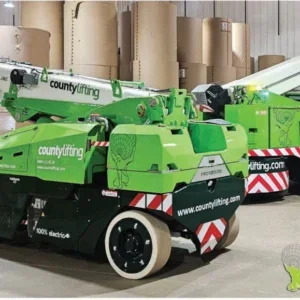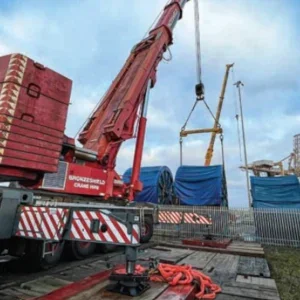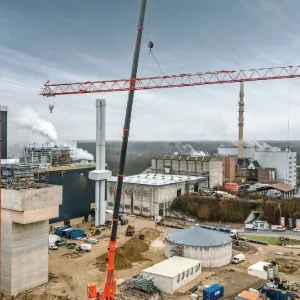Last month (Cranes Today February pp 39-40), I suggested that those people who are looking for fatigue cracks in cranes should first look for obvious telltale signs of cracks, such as rust spots, and then zoom in on the most likely risk areas for more detailed examination. Experienced examiners can use specialised techniques, such as magnetic particle testing, to confirm that what looks like a crack is, or is not.

Grinding away
Magnetic particle testing (MT) is probably the most popular form of non-destructive testing (NDT). The tester uses a hand-held electromagnet to magnetise the surface of the metal. This in turn creates magnetic poles at any discontinuity on the surface. Dusting with finely ground and colour stained iron particles will trace the shape of a crack, undercut, or even scratch on the surface.
Magnetic particle testing is tricky on painted surfaces. One obvious place to search for a crack in the metal is around cracked paint. But the edges of paint cracks are high enough to physically trap the magnetic particles inside the crack. The pattern of magnetic particles trapped in a paint crack resembles the pattern of particles clustered around a crack in metal, and creates what is known as a false positive, a conclusion that the metal has cracked, when in fact it has not necessarily. False positives waste the engineer’s time grinding out cracks that do not exist.
The test is also difficult in the presence of rust, which affects the behaviour of the particles. The tester might conclude that a rusty surface is disrupting a test that has in fact identified a fatigue crack. This is a false negative, a conclusion that the metal has not cracked, when in fact it has. False negatives are more dangerous than false positives because they conceal a weak point in the structure that could lead to a catastrophic failure.
It is possible to do magnetic testing through uncracked paint, although the sensitivity drops so that only larger fatigue cracks-around 20mm long and 3mm deep-are detected. If the paint is thick, the detection is worse. If there is a weld toe involved (as is almost always) the paint meniscus grows thicker as the weld toe angle gets greater. More troubling is that a greater toe angle is more prone to cracking. A greater toe angle is also more prone to create a false positive (non-relevant) MT indication. All this adds up to a degraded sensitivity which could yield false negatives, or false positives that require grinding for a resolution.

Grinding out a fatigue crack
I believe that the best procedure is to grind down every suspect joint down to bright metal, on which magnetic testing works best. Then an exacting characterisation of the type of weld flaw, if it is indeed a flaw, can be made. This type of explorative grinding should be thought of as part of the inspection process. It takes only about five minutes to grind, test, and repeat the process a few times to get a conclusive answer.

Grinding tip
The grinding must be done in a judicious and precise way, or the structure’s strength will be compromised. First, the direction of grinding must be opposite the direction of stress. This almost always means using a rotary grinder (often referred to as a die grinder). A disk grinder will leave grind marks that will be crosswise to the direction of stress, producing fatigue crack initiation sites. Disk grinder marks will also produce a multitude of tiny MT indications running in the same direction as the possible fatigue cracks, thus masking small fine crack indications. Rotary grinding produces grinding marks in the same direction as the stress, and opposite to the direction to the direction of grinding scratches—both good things. Also, whether using abrasive stones or files (burrs), the rotary process usually produces a much smoother grind-out than disks. Although a disk grinder works on something flat, fatigue cracks are rarely found on flat surfaces. Usually the grinding will be needed in tight corners where plates or welds are intersecting at sharp angles.
I personally prefer carbide rotary files to stones, as they cut very fast and do not wear away to an unwanted shape. Please note that the chips that fly off of a carbide cutting tool are very sharp and redundant eye protection is advised.
Improving the structure
Cracked paint, rust stains, and MT indications are all produced by either a crack or a sharp notch or contour. All are bad. A crack is obviously a structural defect, but a sharp notch is bad too. First, it prevents accurate detection of cracking. Second, it promotes cracking. Fatigue cracks invariably start at a sharp notch.
So grinding has two benefits on top of helping to find cracks. First, once shallow cracks are found, they can often be ground out. This would be suitable for the many small fatigue cracks often found during the course of an in-service inspection programme. Findings will probably also find other small weld flaws that escaped manufacturing quality control. Often, these are short and shallow, so grinding to a blended shape of between 1mm and 5mm should be sufficient to fix the problem. Only the more serious cracks will require the more lengthy review and analysis.

Grinding out weld toe
Second, removing sharp bits with grinding can actually help improve the fatigue performance of the structure. The American Welding Society ANSI/AWS D1.1/D1.1M:2006 describes this type of weld toe grinding to improve the fatigue resistance of welds. The removal of this so-called weld toe dramatically improves weld fatigue resistance.
There are two adverse structures at the weld toe that grinding removes. One is the re-entrant angle that a weld bead makes to the adjacent base material, and the other is a tiny but sharp undercut running alongside the weld bead, on almost all welds. This tiny, sharp, discontinuity is doubted by many welding people. After using this grinding treatment with a limit of approximately 0.1mm deep, they will become believers when they see this tiny line, as I have. The UK Welding Institute has called them ‘microscopic intrusions’. The AWS D1.1: 2006 standard suggests a rotary grind treatment to a depth of 0.5mm below any noticeable undercut. Interestingly, few machinery, equipment, or crane codes specifically embrace this technique.
When grinding a spot, the idea is to first grind only enough material away to remove all of the corner and weld undercut. Corners and weld undercut are fatigue breeding grounds. Strange as it may sound, the risks of weakening the structure by grinding out steel are tiny compared to the huge enhancement gained by removing the sharp corner notch. In structures, metal next to a corner only adds to the intensifying of stress at the corner, and not to the overall strength of the structure. This said, it is imperative that a minimum amount of metal be removed.
For most structural and machinery work, a grinding bit of about 10mm diameter is effective. It produces a radius of 6mm that translates to about 2mm of metal removed from the sloping sides of the weld toe and the base metal. Where very small welds (about 5mm) are encountered, the tapered end of a tool can be used, creating a grinding radius of less than a couple of millimetres.
Grinding improves welds, and it also makes it much easier to detect cracks. This said, the author would like to know just how much deeper readers believe they should grind to remove any crack precursors, once there are no detectable defects or notches. [Ed: Letters to the editor on this subject are welcome].
Many welding engineers suggest that small repairs just to fill a shallow low area could do more harm than good. A repair weld imparts shrinkage stresses and yet another weld toe. Compounding this, repair welds, because of a collection of both metallurgical and economic issues, tend to be of lesser quality than production welds unless extreme care and controls are implemented.
Once the exploratory or corrective grind-out has been affected, and no more crack or undercut is apparent, just leaving the grind-out as is can be the best approach. All of the right attributes will be in place: a smooth transition, no weld toe, and unseen “incubating” fatigue cracks reduced or removed.
If a place on the subject structure has cracked once (or even more times), some thought should be put into making a weld that provides for grinding into the preferred contour to resist fatigue cracking, i.e., a smooth transition into the surrounding base material with the weld toe removed.
I suggest that you get a responsive welding engineer to weigh in on this aspect prior to embarking on a fatigue crack finding program. Once a crack is found, the urge to get it fixed and running again can preclude searching for engineering answers.






